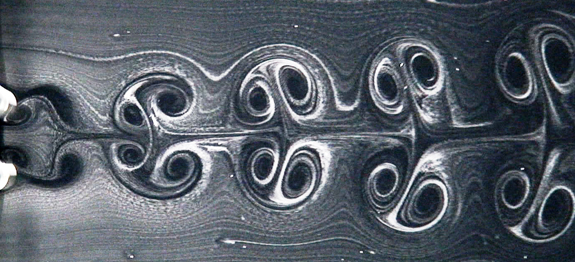Symmetry Breaking in the Wake Behind Two Rotating Cylinders
Sanjay Kumar
Benito Gonzalez
Department of Engineering
The University of Texas at Brownsville

The image represents symmetrical wake structure behind two uniformly rotating cylinders at Reynolds number of 200 and cylinder surface speed to free stream velocity ratio of 1.35.
Flow past a uniformly rotating circular cylinder placed in a uniform flow is a classical fundamental fluid mechanics problem with the fluid region behind the cylinder (wake) exhibiting interesting changes in flow features as the cylinder rotation rate is increased. The figure represent the wake structure behind two uniformly rotating cylinders with both cylinders having the same rotation rates and the cylinder surfaces in between the two cylinders moving in a direction opposite to the main flow direction. This problem has not been investigated in as much detail as the problem of flow past single rotating cylinder. The image represents symmetrical wake structure at Reynolds number of 200. The cylinders are separated such that ratio of center-to-center distance to cylinder diameter is 2.5. The ratio of surface speed of cylinder to free stream velocity is 1.35.
It is found that there is symmetry breaking occurring near this rotation rate at fixed cylinder spacing and Reynolds number, i.e, by changing (decreasing) the rotation rate by very small increment to say 1.30 the wake structure (flow pattern) changes dramatically to a very different pattern showing no symmetry at all. This change has no hysterisis with respect to rotation rate, i.e, one can switch the flow pattern by very small changes in rotation rate. The study increases our understanding of the fundamental fluid physics of this not-so-well studied problem and can have impact on several practical applications involving flow control, on design of devices such as mixers based on this technique, and possibly many more. The flow visualization is done using hydrogen bubble technique.
The research on this problem also used Particle-Image-Velocimetry system, the purchase of which was made possible by NSF grant CMMI - 0723094.
References
S.Kumar, B.Gonzalez, and O.Probst, "Flow past two rotating cylinders," Physics of Fluids (accepted).
Reporters and Editors
Reporters may freely use this image. Credit: Sanjay Kumar and Benito Gonzalez, Department of Engineering, The University of Texas at Brownsville (2010).
